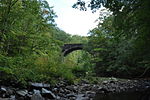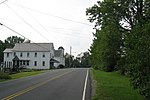Middlefield–Becket Stone Arch Railroad Bridge District

The Middlefield–Becket Stone Arch Railroad Bridge District is a historic district extending through parts of the towns of Chester, Middlefield, and Becket, Massachusetts. The district encompasses a 3.7-mile (6.0 km) stretch of railroad right of way in which there are ten bridge crossings, including nine over the west branch of the Westfield River. The bridges were built in four time periods: 1840, 1866, 1912, and 1928. Nine of the ten bridges are stone or concrete masonry work, and one is a truss girder bridge. All are, with only minor exceptions, in excellent and original condition. The bridges were built to carry the Western Railroad through on its run from the Connecticut River to the Hudson River. This section of railroad was the most expensive the company had to build, costing over $1 million in 1840. The 1840 bridges were designed by George Washington Whistler, and constructed by the firm of Alexander Birney. Of the original nine stone bridges built, only three survive, all of which are now out of service. Some of the bridges were either demolished or encased in concrete during work performed in 1912 and 1927, and one bridge was demolished in 1927. One of the listed bridges (#4) was built of concrete in 1912, adjacent to one of the 1840 stone bridges (#3) that was taken out of service. The one steel truss bridge was built in 1912 by the Pennsylvania Steel Company. The district was added to the National Register of Historic Places in 1980. A hiking trail providing viewing points to the lower seven bridges was opened in 2004. All of the bridges are viewable via whitewater-appropriate watercraft from the river.
Excerpt from the Wikipedia article Middlefield–Becket Stone Arch Railroad Bridge District (License: CC BY-SA 3.0, Authors, Images).Middlefield–Becket Stone Arch Railroad Bridge District
Herbert Cross Road,
Geographical coordinates (GPS) Address Nearby Places Show on map
Geographical coordinates (GPS)
| Latitude | Longitude |
|---|---|
| N 42.312666666667 ° | E -72.993972222222 ° |
Address
Herbert Cross Road
01243
Massachusetts, United States
Open on Google Maps









